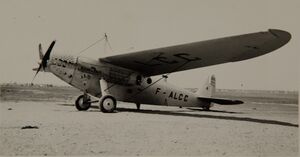Engineering:Blériot 110
| Blériot 110 | |
|---|---|

| |
| Role | Long-distance research aircraft |
| Manufacturer | Blériot Aéronautique |
| Designer | Filippo Zappata |
| First flight | 16 May 1930 |
| Number built | 1 |
The Blériot 110 (or Blériot-Zappata 110) was a French aircraft built in 1930 to attempt new world aerial distance records.
Design and development
Built specifically at the request of the ordered by the Service Technique of the French Air Ministry. it was a two-seat high-wing monoplane constructed of wood.[1] The fuselage was a stressed-skin structure with a teardrop-shaped cross section, with two upper longerons and a ventral keel: the load-bearing covering consisted of three layers of whitewood strips.[2]
It was fitted with six fuel tanks in the wings and four in the fuselage, holding a total of 6,000 L (1,319 Imperial gallons or 1,585 US gal). Because the pilot and co-pilots seats were behind the fuselage fuel tanks, a periscope was fitted for take-offs and landings. A sleeping couch was fitted behind the co-pilot's station so one of the crew members could sleep on long-distance flights.[3]
The aircraft's first flight on 16 May 1930 was cut short by a fuel supply problem, although no damage was sustained. After repairs, it was taken to Oran, Algeria, to make an attempt on the closed-circuit distance record. Between 15 November and 26 March 1932, the Blériot 110, flown by Lucien Bossoutrot and Maurice Rossi, broke this record three times; on the final occasion staying aloft for 76 hours 34 minutes and covering a distance of 10,601 km (6,587 mi). By this time, the aircraft had been named Joseph Le Brix in honour of the pilot who had died flying the 110's rival, the Dewoitine D.33.
On 5 August 1933, Paul Codos and Maurice Rossi set a new straight-line distance record, flying from New York City to Rayak, Syria – a distance of 9,105 km (5,658 mi). Further records were attempted over the next two years, but these were proved unsuccessful, and the 110 was scrapped.
Specifications
General characteristics
- Crew: two pilots
- Length: 14.57 m (47 ft 9 in)
- Wingspan: 26.50 m (86 ft 11 in)
- Height: 4.90 m (16 ft 1 in)
- Wing area: 81.0 m2 (872 sq ft)
- Empty weight: 2,680 kg (5,808 lb)
- Gross weight: 8,790 kg (19,378 lb)
- Powerplant: 1 × Hispano-Suiza 12L , 447 kW (600 hp)
Performance
- Maximum speed: 220 km/h (137 mph, 119 kn)
- Range: 12,600 km (7,830 mi, 6,800 nmi)
- Service ceiling: 2,000 m (6,560 ft)
See also
Aircraft of comparable role, configuration and era
References
- Notes
- ↑ Flight 31 March 1931, p.219 https://www.flightglobal.com/pdfarchive/view/1931/1931%20-%200235.html
- ↑ NACA circular no.138: the Bleriot 110 Pierre Léglise. National Advisory Committee for Aeronautics, Washington, 1931 1931.https://ntrs.nasa.gov/archive/nasa/casi.ntrs.nasa.gov/19930090426.pdf
- ↑ "Mirrors Help Record Ship Take-Off and Land." Popular Mechanic, December 1933, p. 807.
- Bibliography
- Taylor, Michael J. H. (1989). Jane's Encyclopedia of Aviation. London: Studio Editions. pp. 162.
- World Aircraft Information Files. London: Bright Star Publishing. pp. File 890 Sheet 41.
 |


